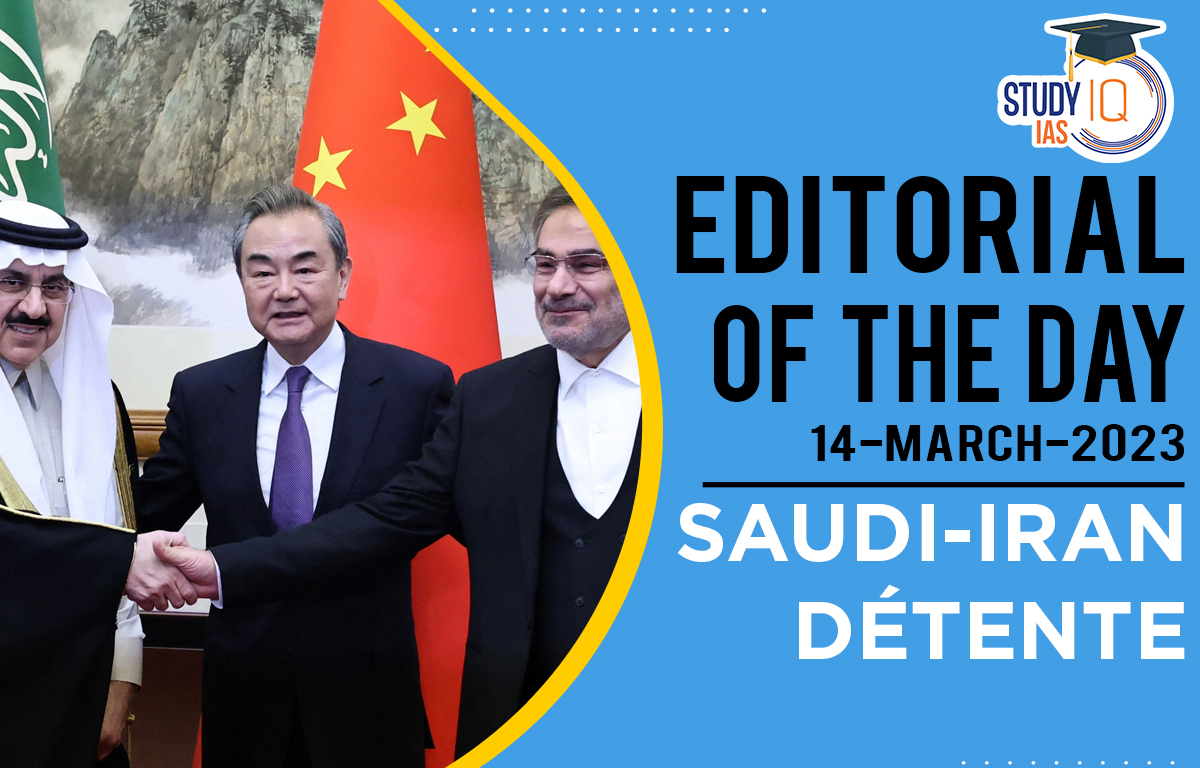Table of Contents
Context: Saudi Arabia and Iran, two of West Asia’s major powers, which have had constrained relations with each other for decades, agreed to restore diplomatic relations last week in an agreement brokered by China.
Background of Relationship between Saudi Arabia and Iran
- Struggle for regional Dominance: The rivalry between the two dates back to pre-revolution Iran when they competed with each other for regional dominance.
- Ideological and sectarian differences: Iran turned into Shia theocratic republic, after the 1979 revolution which ended Iranian monarchy. While Saudi remains a Sunni majority, prolonging the tussle between them.
- Proxies in West Asia: Recently their strife turned into a cold war, where both sides are using their proxies across West Asia. Iran is using Hezbollah, Houthis etc. to create instability in the region while Saudi uses Sunni rebels.
- Collapse of formal ties in 2016 after the Saudi embassy in Tehran was overrun by protesters following Riyadh’s execution of a Shia cleric.
Decoding the Editorial
- Terms of the agreement for restoration of diplomatic relations:
- Iran has agreed to prevent further attacks against Saudi Arabia, especially those from the Houthi-controlled parts of Yemen.
- Saudi Arabia, on its part, agreed to rein in Iran International, a Farsi news channel that is critical of the Iranian regime.
- Reasons for Saudi Arabia’s outreach to Iran:
- Strategic realignments in West Asia: In past few years several strategic realignments have been maneuvered such as UAE normalizing relations with Israel, Israel and Arab countries deepened their partnerships etc. This required Saudi to look for beyond traditional dogmas.
- U.S.’s de-prioritization of West Asia: The U.S., the traditional power of the region, is busy with Russian war in Ukraine and China’s rise in the Indo-Pacific creating a power vacuum. Saudi saw such power vacuum and challenge posed by Iran’s rise as an opportunity to realign.
- Rocky relation between USA and Saudi Arabia: The bedrock of the partnership U.S and Saudi, i.e. Oil trade in 1950s, has become irrelevant now. USA has merged as the top oil producers in the world and is not as dependent on the Gulf Arab.
- Reasons for Iran to accept the deal:
- Economic reasons: Deteriorating economy, falling currency and economic sanctions from the West, required normalizing relations with neighbours for ensuring China’s investment in the country.
- Strategic reasons: Domestic pressure: Sanctions have led to protests in Iran and rising internal pressure required realigning its foreign policy. Furthermore, such a deal could complicate American effort to rally Arab countries and Israel against Iran.
China’s Interest in the Deal
- Economic Interest:
- Trade relations: China is a leading buyer of Saudi oil and the largest trading partner of Iran. This economic leverage with both the countries allowed China to bring the parties closer
- Regional Interest
- China’s arrival as a major power in West Asia: Hitherto, major peace initiatives in the region in the post-War world, was brokered by USA, such as Camp David agreement, Oslo Accords, Abraham Accord etc. But in the Saudi-Iran reconciliation, the U.S. is absent. This points to larger changes under way in the global order.
- Strategic Interest:
- Energy Security: China is the world’s largest oil buyer and stability in the energy market is essential for its continued rise. Deal between Saudi and Iran could stabilize global energy supplies.
- Message to global south that China is brokering peace in the Global South.
USA’s Response to the Deal
- US officials have welcomed the reconciliation and stated that reconciliation between the major rival powers in West Asia would help stabilize the region and benefit the global energy market.
- But strategically, U.S. would in a difficult position given that Iran Nuclear deal is dead and it is lose its influence in West Asia and allies like Saudi drifting away.


 SHANTI Bill 2025: India Opens Nuclear Se...
SHANTI Bill 2025: India Opens Nuclear Se...
 Revamp of MGNREGA Scheme 2025
Revamp of MGNREGA Scheme 2025
 National Energy Conservation Awards 2025
National Energy Conservation Awards 2025

























